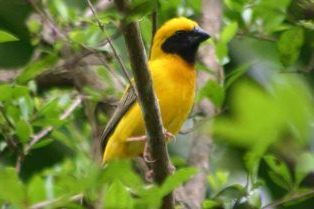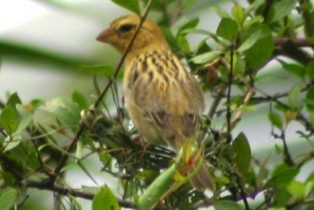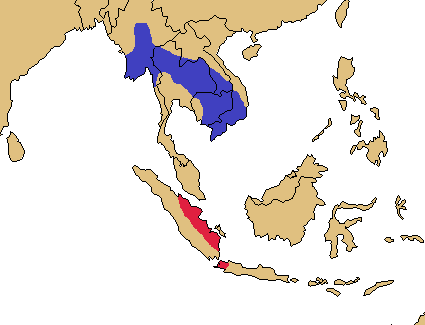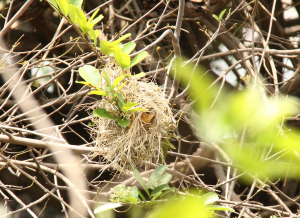Weaver Wednesday [39]: Asian Golden Weaver 2013-03-13 (341)
 Weaver Wednesday
Weaver Wednesday


The Asian Golden Weaver Ploceus hypoxanthus is a Near Threatened species. The breeding male is generally bright yellow with a black mask (diagnostic in Asia). Females, non-breeding males and young birds are dull coloured and difficult to distinguish from the Baya Weaver, but has a thicker bill.
There are two subspecies of the Asian Golden Weaver, with disjunct distributions (see map left, based on Handbook of the Birds of the World, Vol. 15:
P. h. hypoxanthus, found in Indonesia: eastern Sumatra and western Java (see red on map).
P. h. hymenaicus, found in Myanmar (including Tenasserim), Thailand, Laos, Cambodia and southern Vietnam (see blue on map). This subspecies has the feathers of the mantle fringed with a more greenish yellow, and has the upper breast more strongly suffused with raw sienna.

The Asian Golden Weaver was formerly more widespread in Sumatra and Java, but is now localized and uncommon. Its natural habitats are subtropical or tropical seasonally wet or flooded lowland grassland, swamps, and arable land. Its population is showing a continued decline throughout its range as wetlands are converted to agriculture. There is also direct persecution and capture of these weavers for the bird trade, and colonies are often robbed and destroyed by people.
The Asian Golden Weaver feeds mainly on seeds, and even during breeding insects were only 7% of their diet.
The oldest bird is 11 years (see here).
It is apparently monogamous, and perhaps occasionally polygynous. The The Asian Golden Weaver breeds in small colonies. The nest is built initially by the male, and completed with assistance of the female. The nest is a rounded structure with a side entrance, and woven from thin strips of grass or palm leaves. Nests are firmly attached to vegetation over water or very swampy ground, often less than 1m above the surface, usually in reeds or bulrushes. Sometimes nests are placed in trees or shrubs, and then higher than 2 m above the ground. There are several records of nests built close to hornet nests or near biting ants.


The clutch is 2 eggs, rarely 3. Incubation seems to be by the female only. Chicks are fed mainly by female (most often by regurgitation), and rarely by the male. There is no infomation on incubation and nestling periods.
The Asian Golden Weaver has 3 PHOWN records, all small colonies. Many more PHOWN records are needed for this species (see PHOWN summary), especially to document colony size. Submit any weaver nest records to PHOWN (PHOtos of Weaver Nests) via the Virtual Museum upload site.
PHOWN summary
Previous Wedn: Southern Brown-throated Weaver
Full weaver species list
| 

 Weaver Watch
Weaver Watch


